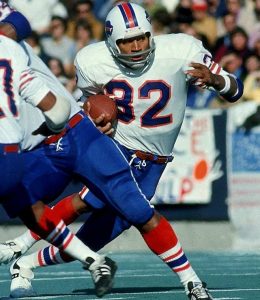A pair of AFC East contenders square off for the second time in a month this Sunday on the NFL’s schedule – the New England Patriots and Buffalo Bills. Our Throwback Thursday feature this week highlights a game played between these 2 teams on opening day of the 1973 season. It was played at New England’s old Shaefer Stadium on September 16 of that year. Both clubs had shown promise in the 1972 season that they might be able to find the promised land of fielding winning teams in this new year. The Bills brought back their old coach from the AFL days, Lou Saban, in ’72 to try to salvage the career of young running back O.J. Simpson, who had languished in his first couple of seasons under coach John Rauch. Rauch came up with the foolish idea of using Simpson as a decoy instead of featuring his talent in the offensive scheme, and even toyed with the idea of switching him to wide receiver. Saban changed all that, building the club around Simpson’s talent to feature the running game. The Bills were also set to move out of their old stadium, the decrepit War Memorial Stadium, into their shiny new home, Rich Stadium.
The Patriots also entered the ’73 season with high hopes, as new coach Chuck Fairbanks attempted to improve the club with young quarterback Jim Plunkett being fortified with an influx of new talent that included Sam Cunningham, Darryl Stingley, John Hannah and Ray “Sugar Bear” Hamilton. That new talent paid immediate dividends as Cunningham scored the game’s first touchdown on a 7 yard run. The Pats missed the extra point, taking a 6-0 lead. It didn’t last long, as a portent of things to come was about to happen. The Bills took the field with a revamped offense designed to feature Simpson’s ability. Three draft picks became immediate starters. A pair of first rounders, Paul Seymour and Joe DeLamielleure, manned the tight end and guard spots, and Joe Ferguson took over for Dennis Shaw at quarterback. Seymour’s role was basically an extra tackle on the line to help Simpson, and when “The Juice” broke off an 80 yard touchdown run to give the Bills a 7-6 lead, Buffalo was off and literally running. Buffalo’s rebuilt line also added center Mike Montler in a trade to go with Reggie McKenzie, Donnie Green and Dave Foley, forming what would be nicknamed the “Electric Company” as they turned on “The Juice”. John Leypoldt added a field goal and Larry Watkins, O.J.’s backfield mate, scored on a 4 yard run to boost the Bills to a 17-6 lead before New England pulled to within 17-13 on a 10 yard Mack Herron run. Then Simpson scored again on a 22 yard scamper. Watkins again joined in the fun, rambling 15 yards to close out the scoring and give Buffalo a resounding 31-13 victory.
When the final gun sounded, Simpson had accumulated 250 yards rushing on 29 carries with his pair of touchdowns, setting a new single-game record for ground yards. Watkins added another 105 yards on 18 carries and his 2 TDs as the Bills racked up an impressive 360 yards on the ground in the game. Simpson’s performance wasn’t a one time deal. He would go on to break Jim Brown’s single season rushing yards record and become the first player in history to break the 2,000 yard barrier as he finished with 2,003 for the year. He is still the only back to achieve the feat in 14 games. Simpson’s personal life has turned tragic and he has frittered away any good will he may have earned in his playing days and broadcasting and acting careers afterwards, but he was a dynamic athlete at one time.

O.J. Simpson shredded the Pats for 250 yards on opening day